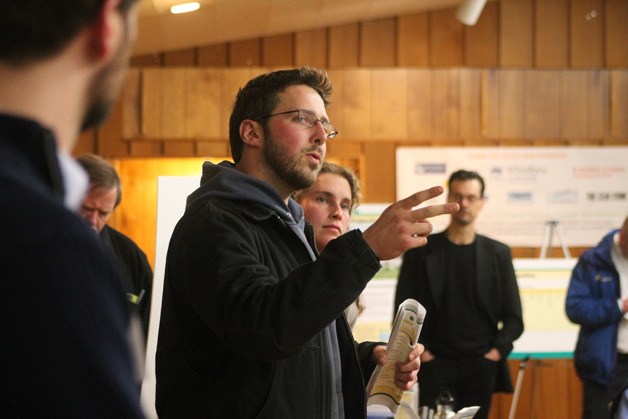Ferry users let state officials have an earful about poor parking considerations and a lack of preparations for emergencies Tuesday night.
The Washington State Department of Transportation came en masse to present the 60-percent design of the proposed multimodal terminal. Estimated to cost $129 million and be completed by 2019, the project is touted for improving connections between different forms of transportation, safety and environmental impact.
The terminal is closer to the rail station for Sound Transit’s Sounder line to Seattle, improves the bus area, and is located where it will move the bulk of ferry operations away from Mukilteo’s Old Town commercial area. Whether that last item is a benefit or a detraction largely depends on one’s take on the ferries’ impact on some of the restaurants and other shops near the current terminal.
As the project’s design progressed over time, some of the originally proposed elements changed or were cut. A parking garage was one of those cut because of a lack of funding, said Washington State Ferries Division Terminal Design Engineering Manager Nicole McIntosh.
“Unfortunately, funding is not available to provide parking at this time,” she said, responding to a couple of questions about a lack of additional parking in the ferry terminal area.
Several people criticized and questioned that loss. Over the years, space for overnight parking has dwindled near the Mukilteo terminal. Most recently, the Mukilteo City Council adopted rules to limit the lighthouse parking lot to a couple of hours and to charge. Ticketing has been enforced.
“I feel a little powerless,” said Clinton commuter Zach Simonson-Bond, who lamented the loss of parking and his inability to affect change about the issue.
Such changes have left commuters like Simonson-Bond with few options. His current ability to pay for parking at a private business near the waterfront is in jeopardy because that building is in the path of the new road the Washington State Department of Transportation needs to build from the existing highway to the proposed terminal site. That means the building and the private parking lot are coming down.
“That monthly commuter parking is important to a lot of us,” he said during a comment section demanded by the 70-or-so people who crowded Clinton Community Hall to hear about and criticize the terminal project. “And we’re losing it rapidly.”
Later, Simonson-Bond commended the state employees for handling the at-times unruly crowd well. He even praised them for the cultural designs that incorporate light, energy efficiency and Coastal Salish icons and images into the look of the passenger terminal. But those things do not help him get home to Whidbey Island after a long day working in Seattle.

The demand for parking on the Mukilteo side of the state highway, of which the ferry route is an extension, was heard loud and clear by the ferries division and transportation department employees.
“I get that, I’ve heard, ‘Parking, parking, parking,’ ” said Charlie Torres, the state’s Mukilteo multimodal facility project manager.
Another feature that was roundly lambasted was the lack of a second slip at the terminal. Commuters recalled times when the existing Mukilteo terminal was out of operation. That meant they were rerouted to the Edmonds terminal, a significant change to their commutes.
A second slip could also accommodate for three-boat service, other people said at the meeting. No three-boat service is planned for the Clinton-to-Mukilteo route, but has been championed by some Whidbey Island commuters as a possible way of reducing wait times.
Maury Hood, a Clinton resident, warned the ferries division against demolishing the existing Mukilteo terminal. In the event that the new one is out of operation, a backup would be in the immediate area.
Leaving the existing terminal isn’t possible. McIntosh said its removal was a condition of the permit for the new facility. The walk-on passenger span of the new terminal is designed as such that, if money became available for a second slip, it would easily service the second slip built to the southwest.

“We’re not precluding two slips,” Torres said. “But we’re only funded for one.”
Other considerations had people questioning how accessible the rail station will be to and from the ferry terminal. Torres said a separated walkway from the Sound Transit rail platform to the ferry terminal is about 800 feet. A couple of women criticized that distance for not accommodating differently abled and mobility-impaired people. That entire stretch is uncovered. It should pass muster for Americans with Disabilities Act compliance, said Howard Fitzpatrick of LMN Architects in Seattle. Some of the design work was contracted out by the ferries division to LMN and Fitzpatrick.
Even those who complimented the project threw in a barbed comment. Doug Hofius, an architect who lives in Clinton, commended the design of the terminal but critiqued the maintenance and staff building that will face the seven, 700-foot vehicle holding lanes.
“But that maintenance building, four million visitors are going to be looking at it, and it’s kind of a turd,” he said, drawing laughs from the tense crowd.
With the general look and operation of the new multimodal facility penciled out, the department of transportation will look at the specifics of actually building it. The next marker for when the state will return for a public comment/input meeting will be close to the 90 percent design, ferries employees said.


